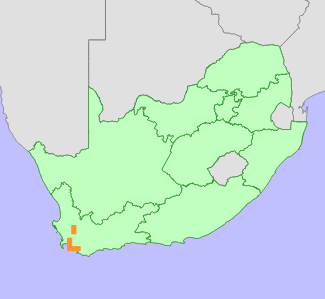|
Scientific Name | Ixia sarmentosa Goldblatt & J.C.Manning |
Higher Classification | Monocotyledons |
Family | IRIDACEAE |
Synonyms | Ixia polystachya L. var. lutea in sense of Lewis (1962), not of Ker Gawl. (misapplied name) |
National Status |
Status and Criteria | Endangered B1ab(i,ii,iii,iv,v) |
Assessment Date | 2015/06/30 |
Assessor(s) | L. von Staden |
Justification | EOO 3581 km², between seven and 10 isolated, severely fragmented subpopulations continue to decline due to ongoing habitat loss, degradation and competition from unmanaged alien invasive plants. |
Distribution |
Endemism | South African endemic |
Provincial distribution | Western Cape |
Range | Porterville to Kleinmond and Hermanus. |
Habitat and Ecology |
Major system | Terrestrial |
Major habitats | Cape Winelands Shale Fynbos, Boland Granite Fynbos, Hangklip Sand Fynbos, Swartland Alluvium Fynbos |
Description | Seasonally wet, lowland flats and slopes. |
Threats |
| This species has already lost most of its habitat in the northern parts of its range to agricultural expansion, and only one confirmed, isolated subpopulation remains in this area. Around Stellenbosch it has also lost habitat to crop cultivation as well as timber plantations on the lower slopes of Simonsberg, where one known remaining subpopulation is threatened by competition from spreading, unmanaged invasive pines. Around Somerset West it is known from one subpopulation protected within the Helderberg Nature Reserve, but is also likely to have declined due to urban expansion on the surrounding lower slopes of Helderberg Mountain in the past. On the coast between Betty's Bay and Hermanus, this species continues to be threatened by habitat loss to coastal development, as well as competition from unmanaged alien invasive plants. |
Population |
This species is rare and poorly known, but may also be overlooked due to taxonomic confusion. Subpopulations are scattered, and isolated due to habitat loss and fragmentation. Population data available for one subpopulation indicate that this species occurs as small, localized groups of individuals. It continues to decline due to ongoing habitat loss and degradation across its range.
|
Population trend | Decreasing |
Notes |
| This poorly known species is often confused with another yellow-flowered, but more common species, Ixia dubia, and the two species co-occur in places. Specimen collections are essential to differentiate the species. |
Assessment History |
Taxon assessed |
Status and Criteria |
Citation/Red List version | | Ixia sarmentosa Goldblatt & J.C.Manning | EN B1ab(i,ii,iii,iv,v) | 2017.1 | | Ixia sp. nov. (Goldblatt & Manning 13747 NBG) | EN B1ab(i,ii,iii,iv,v) | 2015.1 | | Ixia polystachya L. var. lutea (Ker Gawl.) G.J.Lewis | Least Concern | Raimondo et al. (2009) | |
Bibliography |
Goldblatt, P. and Manning, J.C. 2016. Systematics of the southern African genus Ixia L. (Iridaceae): 5. Synopsis of section Ixia, including five new species. South African Journal of Botany 104:175-198.
Raimondo, D., von Staden, L., Foden, W., Victor, J.E., Helme, N.A., Turner, R.C., Kamundi, D.A. and Manyama, P.A. 2009. Red List of South African Plants. Strelitzia 25. South African National Biodiversity Institute, Pretoria.
|
Citation |
| von Staden, L. 2015. Ixia sarmentosa Goldblatt & J.C.Manning. National Assessment: Red List of South African Plants version . Accessed on 2025/05/31 |
 Comment on this assessment
Comment on this assessment

